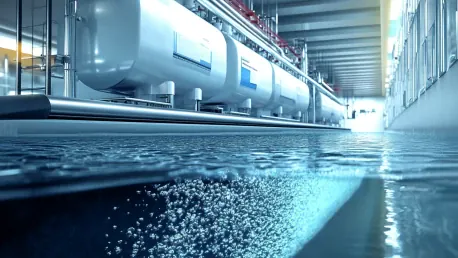The updated Ballast Water Management (BWM) Convention regulations, which came into effect on February 1, 2025, have introduced pivotal changes that underscore the essential role of digital technology in ensuring the shipping industry’s compliance. Authored by Tommi Vihavainen, the detailed piece sheds light on how insufficient record-keeping can lead to breaches, emphasizing the recent regulatory updates, their environmental importance, and the practical consequences for shipowners and seafarers alike.
Evolving Regulatory Landscape
Historical Context
The BWM Convention, which was first adopted in 2004, was the culmination of global efforts to address the harmful impacts of invasive aquatic species transported via ships’ ballast water. These species disrupt marine ecosystems and biodiversity significantly, presenting threats similar to those posed by greenhouse gas emissions. As a result, stringent management measures have been deemed necessary. Over the past two decades, the Convention has evolved in response to growing ecological insights and technological advancements, leading to a more refined and enforceable regulatory framework.
These regulatory advancements reflect a comprehensive understanding of the operational complexities and the necessity for robust compliance mechanisms. The introduction of mandatory ballast water treatment systems (BWTS) plays a pivotal role in curbing the spread of invasive species. The continuous refinement of the Convention underscores the global commitment to protecting marine environments. By keeping pace with technological developments, the IMO ensures that the BWM Convention remains relevant and effective, driving environmental preservation efforts forward.
Significance of the 2025 Updates
The 2025 updates to the BWM Convention, endorsed by the International Maritime Organization’s Marine Environment Protection Committee (MEPC) during its 82nd session, mark a significant milestone for international vessels exceeding 400 gross tonnes. The updates compel shipowners and operators to adhere to newly introduced mandatory changes, created to enhance compliance and environmental protection eagerly anticipated by the maritime industry. The increased rigor in the regulatory framework aims to mitigate the ecological risks posed by unregulated ballast water discharges.
One of the most notable changes is the structured approach to improved record-keeping, which encompasses detailed data fields that ensure precision and timeliness in submissions. The updated provisions require vessels to maintain comprehensive records in an organized format, thereby eliminating any ambiguities that could lead to regulatory breaches. This proactive stance taken by the IMO establishes a standardized process for reporting and compliance, which not only safeguards marine ecosystems but also promotes accountability among shipowners and operators.
Key Changes and Requirements
Enhanced Record-Keeping Mandates
Central to the 2025 updates is the introduction of enhanced record-keeping mandates for ballast water management. Ships are now required to maintain Ballast Water Management Record Books (BWRBs) either electronically or on paper, adhering to a more structured and detailed format. These books include meticulously defined data fields, designed to ensure precise and timely entries. By imposing stricter deadlines for report submissions, the updates aim to enforce greater accuracy and consistency in record-keeping across the maritime industry.
The move towards electronic BWRBs is particularly noteworthy, as it leverages digital technology to reduce the administrative burden on seafarers. Automation of data entries minimizes the risk of human error, which is indispensable for maintaining compliance with the new regulations. Furthermore, these digital records can be easily accessed and audited, enhancing transparency in the compliance verification process. This shift not only redefines best practices within the industry but also demonstrates a clear commitment to upholding environmental standards.
Operational Scenarios for Challenging Water Quality
The 2025 updates to the BWM Convention also address the operational challenges posed by water quality conditions in certain ports, notably in high-sediment areas like the Port of Shanghai. The MEPC 82 introduced two new operational scenarios, termed scenarios three and four, specifically designed to manage ballast water management system (BWMS) bypasses under challenging water quality (CWQ) conditions. These scenarios necessitate the precise logging of actions taken during such instances, ensuring that all activities are thoroughly documented and comply with regulatory standards.
By providing clear guidance for BWMS operations in CWQ conditions, the updates mitigate the risk of non-compliance due to unforeseen environmental factors. These proactive measures ensure that shipowners and operators can adapt their ballast water management practices to varying water quality without compromising regulatory adherence. The implementation of these scenarios underlines the IMO’s commitment to enhancing the resilience and adaptability of the maritime industry, fostering a culture of responsible environmental stewardship.
Technological Solutions for Compliance
Digital Logbook Technologies
Digital logbook technologies are at the forefront of simplifying compliance with the new ballast water management regulations. By transitioning from traditional paper-based methods to digital systems, the shipping industry can significantly reduce the administrative burden associated with manual data entry. Electronic logbooks provide a streamlined solution that enhances data accuracy and consistency, enabling seafarers to focus on essential operational tasks and responsibilities. These technologies ensure that records are maintained accurately and can be readily accessed for compliance verification.
The shift towards digital solutions is a game-changer for the maritime industry, facilitating seamless adaptation to the new regulatory framework. Digital logbooks offer real-time data entry and synchronization, allowing for efficient monitoring and reporting of ballast water management activities. This transition not only enhances compliance but also contributes to improved operational efficiency. By leveraging digital tools, the industry can achieve greater transparency and accountability in ballast water management, ultimately safeguarding marine ecosystems from the adverse impacts of invasive species.
Practical Benefits for Shipowners and Crew
For shipowners and crew, the integration of digital tools presents several practical benefits that extend beyond compliance with the BWM Convention’s enhanced requirements. Digital Ballast Water Management Record Books (BWRBs) eliminate redundancies in maintenance procedures, streamline documentation processes, and improve overall operational reliability and safety. By simplifying the record-keeping process, digital solutions reduce the risk of errors and enhance the accuracy of data, ensuring that ships remain compliant with the stringent regulatory standards.
Moreover, the implementation of digital technologies fosters a culture of accountability and precision within the maritime industry. Shipowners can ensure that their vessels meet the necessary regulatory requirements while simultaneously improving operational efficiency. This dual benefit highlights the importance of embracing digital solutions in the current regulatory landscape. As the maritime industry continues to evolve, the adoption of digital logbook technologies will be essential for maintaining compliance and promoting sustainable practices across the board.
Broader Implications and Future Trends
Proactive Environmental Stewardship
The updated BWM Convention’s emphasis on stricter documentation and enhanced record-keeping requirements underscores the global commitment to proactive environmental stewardship. By mandating comprehensive records of ballast water management activities, the IMO aims to foster increased accountability and transparency within the maritime industry. This approach ensures that shipowners and operators are actively engaged in protecting marine biodiversity and maintaining compliance with international environmental standards.
These stringent requirements also encourage the maritime industry to adopt best practices that prioritize environmental protection. By embedding a culture of meticulous record-keeping and adherence to regulatory standards, the industry can contribute to global efforts to combat the spread of invasive species and safeguard marine ecosystems. The updates to the BWM Convention signal a shift towards a more sustainable and responsible approach to ballast water management, reflecting the broader trend of integrating environmental considerations into maritime operations.
Technological Integration for a Sustainable Future
Embracing technological advancements is crucial for the maritime industry’s ability to meet evolving administrative responsibilities and regulatory standards. The integration of digital solutions not only simplifies compliance but also enhances operational efficiency and promotes sustainable practices. As the industry faces increasing regulatory demands, the adoption of digital technologies will be instrumental in ensuring that shipowners and operators can effectively manage their documentation and reporting obligations.
Looking ahead, the continued advancement of digital tools will drive innovation in ballast water management and other areas of maritime operations. By staying ahead of technological trends, the industry can achieve greater resilience and adaptability in the face of evolving environmental and regulatory challenges. The successful implementation of digital solutions will be key to fulfilling the industry’s environmental obligations, protecting marine biodiversity, and securing a sustainable future for generations to come.
Conclusion
The revised Ballast Water Management (BWM) Convention regulations, effective February 1, 2025, bring significant changes highlighting the critical role of digital technology in maintaining compliance within the shipping industry. Authored by Tommi Vihavainen, the comprehensive article delves into how inadequate record-keeping can result in regulatory violations. It emphasizes the latest updates to the regulations, their environmental significance, and the practical effects for shipowners and seafarers. The new rules stress the need for meticulous documentation and digital solutions to track and manage ballast water discharge effectively. Additionally, Vihavainen discusses the broader impact of these changes on the maritime industry, underscoring the importance of protecting marine ecosystems from invasive species through better regulatory frameworks and technological advancements. This deeper understanding of the BWM Convention assists maritime stakeholders in navigating the evolving landscape and ensuring adherence to heightened environmental standards.









